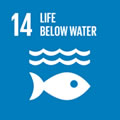Por favor, use este identificador para citar o enlazar a este item:
http://hdl.handle.net/10261/341528COMPARTIR / EXPORTAR:
 SHARE SHARE
 CORE
BASE CORE
BASE
|
|
| Visualizar otros formatos: MARC | Dublin Core | RDF | ORE | MODS | METS | DIDL | DATACITE | |

| Título: | Buoys are non-indigenous fouling hotspots in marinas regardless of their environmental status and pressure |
Autor: | Sempere-Valverde, Juan; Castro Cadenas, María Dolores; Guerra-García, José Manuel; Espinosa, Free; García-Gómez, José Carlos; Ros, Macarena | Palabras clave: | Coastal invasions Artificial habitats Ecological engineering Urban ecosystems Fouling |
Fecha de publicación: | ene-2024 | Editor: | Elsevier | Citación: | Science of the Total Environment 909: 168301 (2024) | Resumen: | Marinas contribute to the degradation of coastal ecosystems, constitute non-indigenous species (NIS) hotspots and function as steppingstones in invasion processes. These often enclose highly modified water bodies that promote the concentration of pollutants and propagules, favoring NIS abundance. In these habitats, floating structures are often the most invaded by fouling NIS. This study aims to address the effect of floating substrate (buoys vs pontoons) on fouling assemblages, with special focus on NIS, in 6 marinas of Cadiz Bay during summer and winter seasons. Since the effect substrate type can depend on the water physicochemical conditions and environmental state and pressures of marinas, an environmental assessment was carried out for each marina using literature, physicochemical water measurements and environmental risk assessments. Despite the registered seasonal variation in fouling assemblages and the environmental variability among the studied marinas, the type of substrate played a key role in fouling assemblages' structure and abundance. The higher abundance of fouling assemblages in buoys than pontoons favor NIS prevalence in marinas and increase the risk of NIS dispersal, particularly considering that buoys are more likely to detach and drift at sea than pontoons. The results indicate that high-risk consideration should be given to this substrate type and that the potential environmental effects of biological pollution must be considered in risk assessments | Descripción: | 11 pages, 6 figures, 4 tables, supplementary material https://doi.org/10.1016/j.scitotenv.2023.168301.-- Data availability: Data will be made available on request | Versión del editor: | https://doi.org/10.1016/j.scitotenv.2023.168301 | URI: | http://hdl.handle.net/10261/341528 | DOI: | 10.1016/j.scitotenv.2023.168301 | ISSN: | 0048-9697 | E-ISSN: | 1879-1026 |
| Aparece en las colecciones: | (ICM) Artículos |
Ficheros en este ítem:
| Fichero | Descripción | Tamaño | Formato | |
|---|---|---|---|---|
| Sempere_et_al_2024.pdf | 5,23 MB | Adobe PDF |  Visualizar/Abrir | |
| Sempere_et_al_2024_suppl.docx | 979,57 kB | Microsoft Word XML | Visualizar/Abrir |
CORE Recommender
SCOPUSTM
Citations
1
checked on 07-may-2024
Page view(s)
25
checked on 07-may-2024
Download(s)
26
checked on 07-may-2024
Google ScholarTM
Check
Altmetric
Altmetric
Este item está licenciado bajo una Licencia Creative Commons



